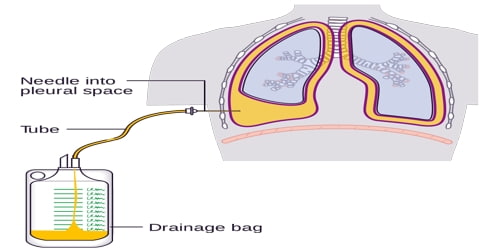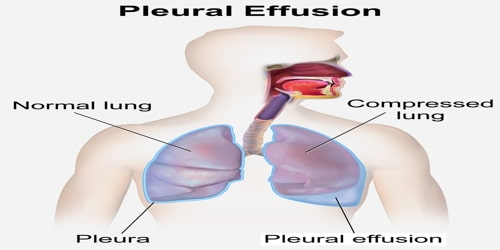Pleural Effusion
Definition: A pleural effusion is a buildup of fluid in the space between the lungs and chest cavity, called the pleural space. It is also commonly called water on the lung. Various kinds of pleural effusion, depending on the nature of the fluid and what caused its entry into the pleural space, are hydrothorax (serous fluid), hemothorax (blood), urinothorax (urine), chylothorax (chyle), or pyothorax (pus). A pneumothorax is the accumulation of air in the pleural space, and is commonly called a “collapsed lung”.
- Various methods can be used to classify pleural fluid.
- By the origin of the fluid:
- Serous fluid (hydrothorax)
- Blood (haemothorax)
- Chyle (chylothorax)
- Pus (pyothorax or empyema)
- Urine (urinothorax)
Pleural effusion may also be referred to as effusion or pulmonary effusion. The type of fluid that forms a pleural effusion may be categorized as either transudate or exudate.
Transudate is usually composed of ultrafiltrates of plasma due to an imbalance in vascular hydrostatic and oncotic forces in the chest (heart failure, cirrhosis).
Exudate is typically produced by inflammatory conditions (lung infection, malignancy). Exudative pleural effusions are usually more serious and difficult to treat.

Causes and Symptoms of Pleural Effusion: There are many causes of pleural effusions. The following is a list of some of the major causes:
- Congestive heart failure
- Kidney failure
- Infection
- Malignancy
- Pulmonary embolism
- Hypoalbuminemia
- Cirrhosis
- Trauma
The development of a pleural effusion occurs from fluid seeping into the pleural space, a thin area between the visceral and pleural membranes in the chest cavity, which normally contains a small amount of fluid to facilitate smooth lung movement. Fluid under pressure, malignant cells, and infectious agents can occasionally enter this space and cause it to expand with abnormal amounts of fluid and other compounds.
Physical symptoms of a pleural effusion commonly show up as liquid fills the chest cavity. These symptoms include:
- dry, unproductive cough
- difficulty breathing, especially when lying down
- fever
- chest pain
- shortness of breath
- inability to take deep breaths or pain caused by taking deep breaths
Some people do not experience symptoms of pleural effusion at all. They usually find out about the liquid in their lungs after a physical exam for an unrelated condition.
The signs and symptoms of pleural effusion may also be confused with other lung disorders. People should schedule an appointment with their doctor immediately if they experience these symptoms.

Diagnosis and Treatment of Pleural Effusion: A pleural effusion is usually diagnosed on the basis of medical history and physical exam, and confirmed by a chest X-ray. Other imaging tests, such as CT scan, may be ordered to further identify the possible cause and the extent of the pleural effusion.
Diagnosing the cause(s) of a pleural effusion often begins with determining whether the fluid is transudate or exudate. This is important because the results of this fluid analysis may provide a diagnosis and determine the course of treatment.
The treatment for pleural effusion depends on the disorder in the body that is causing it. In addition to treating the condition that is causing the effusion, in most cases, doctors will drain the fluid from the chest.
Some pleural effusions (mainly exudative) may require surgery to break up adhesions, while others may require pleurodesis (pleural sclerosis), a procedure whereby different irritant substances or medications are inserted into the pleural space in order to fibrose and scar the visceral and pleural surfaces together. This procedure seals the pleural space so that pleural effusions have difficulty reaccumulating.
Information Source:
















